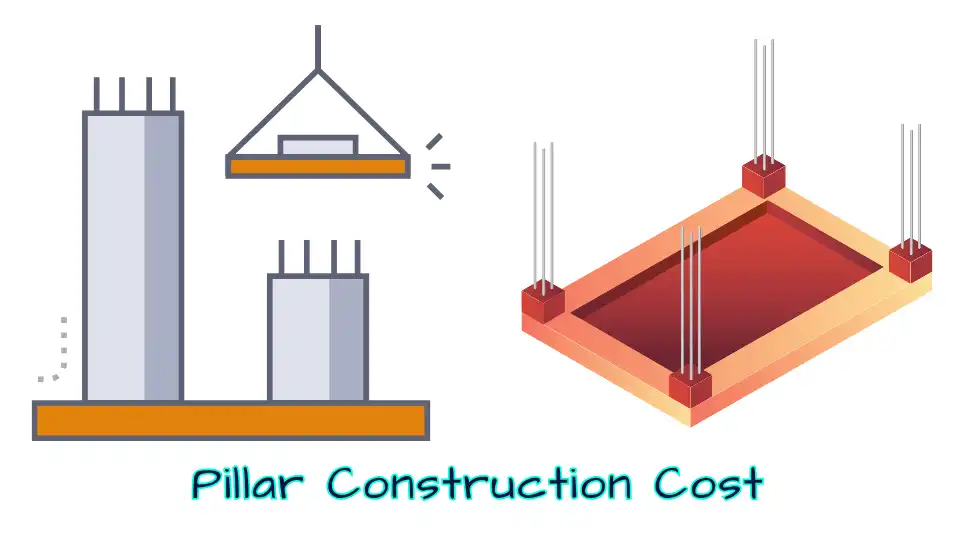Pillar & Column Cost Calculator
This calculator is the centerpiece of our guide. It uses standard engineering formulas and up-to-date approximate rates for a major metro city to give you a detailed and realistic cost estimate.
Calculate Your Pillar Construction Cost
Enter your pillar’s specifications and current market rates for an instant, detailed estimate.
1. Pillar Dimensions
2. Concrete Details
3. Steel Reinforcement
4. Other Costs
Pillar Construction Cost (2025)
Planning a construction project? and wondering pillar construction cost Our 2025 guide breaks down pillar construction costs, including materials (concrete, steel), labor, and formwork. Use our free, detailed column cost calculator for an instant estimate tailored to metro city rates.
Planning to build in a bustling metropolis like Mumbai? Whether it’s a new floor on your family home in Thane or the foundation for a commercial project in Andheri, understanding the core construction costs is paramount. And at the heart of any stable structure are its pillars, or columns. They are the silent workhorses that hold everything up.
But how much does it really cost to build a single pillar in 2025? The answer is more complex than a simple number. It depends on a variety of factors, from the size of the pillar to the market price of steel on the day of purchase.
This guide will provide you with a comprehensive breakdown of every expense involved. We’ll explore the key cost-influencing factors, give you a step-by-step calculation, and present our new and improved interactive calculator to give you a reliable, instant estimate for your project.

Key Factors Influencing Pillar Construction Cost
The final price tag on a pillar is a sum of several moving parts. Here’s what you need to keep on your radar:
1. Pillar Size and Dimensions
This is the most obvious cost driver. A taller, wider, and deeper pillar requires a larger volume of concrete and more steel for reinforcement. It’s a simple equation: more volume = more material = higher cost.
2. Concrete Grade (Mix Ratio)
Concrete is specified by its compressive strength, denoted by grades like M20 or M25. The ‘M’ stands for Mix, and the number is its strength in N/mm² after 28 days of curing. For structural work in India, M20 is the minimum grade specified by the IS 456:2000 code of practice for RCC (Reinforced Cement Concrete).
- M20 (Ratio 1:1.5:3): The standard for most residential columns, beams, and slabs. (1 part Cement, 1.5 parts Sand, 3 parts Aggregate)
- M25 (Ratio 1:1:2): A stronger, more cement-rich mix used for structures demanding higher strength.
Higher-grade concrete is more expensive due to the higher proportion of cement.
3. Steel Reinforcement (Rebar)
Steel provides the tensile strength that concrete lacks, making it a critical—and costly—component. The cost is determined by:
- Quantity and Diameter of Main Bars: These are the thick vertical bars that form the pillar’s skeleton. Common diameters are 12mm, 16mm, and 20mm.
- Spacing and Diameter of Stirrups (Ties): These are thinner bars (often 8mm) that wrap around the main bars. They prevent the main bars from buckling and resist shear forces. Closer spacing means more steel is needed.
Steel prices are volatile and quoted per kilogram (kg) or tonne.
4. Formwork (Shuttering)
Formwork is the temporary mold that holds the wet concrete in place while it sets. The cost depends on:
- Material: Traditional timber or plywood formwork is common. Steel shuttering is more expensive upfront but is reusable, provides a superior finish, and is often used by larger contractors.
- Pillar Shape: A standard square or rectangular column is far cheaper to form than a circular, L-shaped, or architecturally complex one.
5. Labor Costs
In a city like Mumbai, labor is a significant expense. You’ll be paying for skilled labor (masons, bar-benders, carpenters for formwork) and unskilled labor. Rates in metropolitan areas are substantially higher than in Tier-2 or Tier-3 cities.
6. Geographical Location
This can’t be stressed enough. The rates for cement, sand, aggregate, and labor can vary even between different zones of a large metro area like the MMR (Mumbai Metropolitan Region). Sourcing materials from a supplier in Vasai-Virar might be cheaper than sourcing from South Mumbai, but transportation costs could offset the savings.